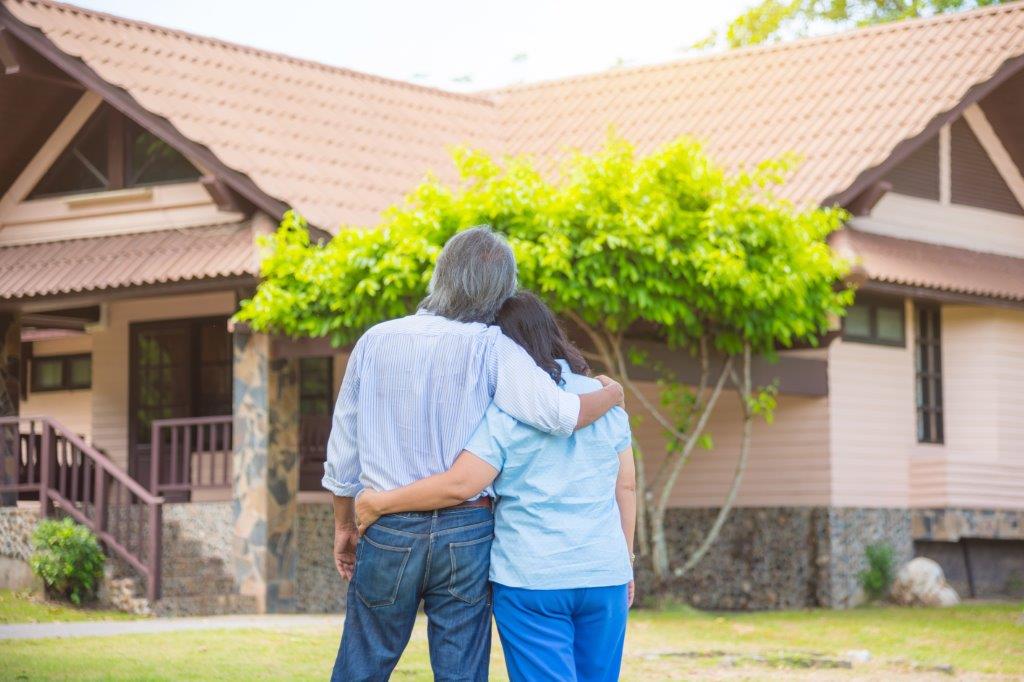
A couple is standing outside their forever home and reflecting on happy they are to have this dwelling for their long-term needs so they can remain living here as they age in place .
Aging in place is constant
From the moment we are born, we are aging in place. At that very early age, we aren’t aware that we are aging in place, but we are. We aren’t aware of much except our own needs. Our parents or guardians are taking on this responsibility of providing living accommodations for us, just as they are providing for our food, well-being, comfort, and other needs in addition to our shelter.
Nevertheless, aging in place isn’t something that we suddenly realize is happening or that we need to choose to embrace or be a part of – it happens whether we agree to it or not. Aging in place means making the most of our current living situation whether we do anything to improve our surroundings or merely live in them.
Aging in place happens wherever we are living at the time – and at whatever age we happen to be. The more we are aware of it, and the more we embrace it, the better our outcome and quality of life can be, but there is no requirement that any minimum level of acceptance or activity occurs.
We don’t age out of adulthood
As we get older, from that very earliest time that we can remember or that we have been reminded by adults around us, or perhaps shown to us in pictures or videos they have taken to record various moments in our life, we transition through the various milestones or stages of life.
Likely, one of the first such milestones we recall, or that we looked forward to achieving, was starting school. For some, it may have been starting preschool or daycare. For others, it possibly was being home-schooled. Nevertheless, starting the path to a formal education was a memorable achievement for us.
There are so many other milestones or achievements in life that simply being the required age entitled us to attain – driving a car, voting, having a drink, signing contracts on our own, applying for a professional license, renting a car, or running for elective office, for instance.
That said, once we pass through our childhood years and adolescence, we are adults. We continue getting older and passing through other maturation phases. We might want to consider becoming a senior as one of those stages or events of life. Even at that, the definition of what is a senior is subject to interpretation and self-identification.
We age out of childhood and adolescence, but once we become adults, we remain adults. We just get older along the way – moving from young adults to mature adults.
Aging in place meets us where we are
We know that there are various stages of life – newborn, toddler, childhood, adolescence, young adulthood, and then various stages of maturity beyond that. During each stage that we pass through or remain in, there are various activities, accomplishments, and challenges for us to meet. We are becoming more of the person that will ultimately define us and impact those around us, including younger generations.
The home that we have selected to occupy – because of its location, layout, or price (it was what we thought we could afford at the time even if it didn’t have everything we were looking for) – soon began to take on our personality. We redefined that living space to coincide with our needs.
Over time, we repurposed our living space with our own furnishings, wall colors, flooring, and the way we wanted to use the space. We put our stamp on it. It was now ours. Regardless of how other people had used this home who had occupied it before we did (unless it is new construction and we are the first occupants), it now resembles our needs or soon will, as this may be an ongoing process. We have repurposed and redefined the space to reflect how we want to use it.
Our homes need to work for us and be a reflection of how we are going to be safe and comfortable in the space. It may not work as well for someone else, or they may not like our color and furnishing choices, but this is fine. Aging in place is personal and just needs to serve the needs of the occupants of the home.
As we continue occupying our selected living space, it will continue to reflect our needs and allow us to function well within it. There will be minor tweaks and adjustments along the way to bring out living space into even more alignment with what we want it to be for us long-term as we remain in the home and age in place.
